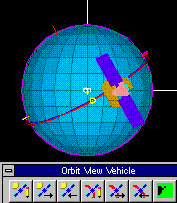|
 RadCAD is a thermal radiation analyzer available for use with Thermal Desktop
or stand alone. RadCAD uses Monte Carlo Ray Tracing to calculate form factors,
radiation conductors, and heating rates for true conic surface representations
for input into SINDA/FLUINT. RadCAD is the first radiation analyzer to integrate
arbitrary CAD generated surfaces with familiar parameter-based (TRASYS like)
surfaces. RadCAD is a thermal radiation analyzer available for use with Thermal Desktop
or stand alone. RadCAD uses Monte Carlo Ray Tracing to calculate form factors,
radiation conductors, and heating rates for true conic surface representations
for input into SINDA/FLUINT. RadCAD is the first radiation analyzer to integrate
arbitrary CAD generated surfaces with familiar parameter-based (TRASYS like)
surfaces.
Why use RadCAD
There are many reasons to use Thermal Desktop/RadCAD and a full report can
be found here. A quick summary of the three major reasons is listed below.
- Thermal Desktop/RadCAD uses snap on model building. Thermal
Desktop is CAD based. This allows Thermal Desktop to take full advantage of
CAD model building. Whether you are sketching your Thermal Desktop surfaces
over an IGES wireframe or snapping new surfaces to the referenced points of
existing surfaces, you'll find that you are building your model more
accurately and faster than ever.
- Thermal Desktop/RadCAD runs on a PC. Finally, the thermal
engineer doesn't need two computers. Thermal Desktop runs on the same PC
under the same OS as your word processing system (see system requirements
for details). No more transferring your phone and going to a computer room.
You can work right at your desk and easily switch between developing your
model and documenting it.
- RadCAD is fast. RadCAD uses proprietary advances in Monte Carlo
ray tracing to achieve remarkable calculation speed. One significant advance
is the progressive radiosity routine used to turn view factors into
radiation conductors. At C&R, we are keeping up with the latest technology
to provide users with the fastest most accurate solution possible.
RadCAD Features
- Monte Carlo Ray Tracing to calculate form factors, radiation conductors,
and environmental heating
- Calculations using Monte Carlo ray tracing or advanced radiosity methods
- Proprietary advances in Oct Cell technology for amazingly fast
computations
- True curved geometric surfaces
- Specular and Diffuse surfaces
- Angular dependent surface properties
- Variable model geometry with planet, sun, and star tracking
- Full Orbit plotting package with both basic and Keplerian input
- Analysis groups offer significant speed savings
- Optical Property Aliases help in database management
- Refraction capabilities for transparent specular surfaces
- Automatic Oct Cell optimization for determining best subdivision and
surfaces per cell criteria
- Articulators can now be functional between user specified orbit
positions
- Vector List Orbit definition for modeling trajectory orbits
- Arbitrary source input for modeling IR/Sol Lamps
- Fast spinning surfaces
- Symmetry/Mirror planes
- Automatic restart determination
- Free Molecular Heating (FMH) algorithms have been added to allow
calculation of heating loads during ascent of launch vehicles
- Quick checks to allow for finding surfaces that overlap to aid in
radiation model debugging
Import and Export Capabilities
- TRASYS import and export
- Nevada import
- STEP-TAS import and export
- IDEAS import
- FEMAP import
- STEP-209 import and export
- NASTRAN import and export of temperature mapping
- TSS import and export
|









